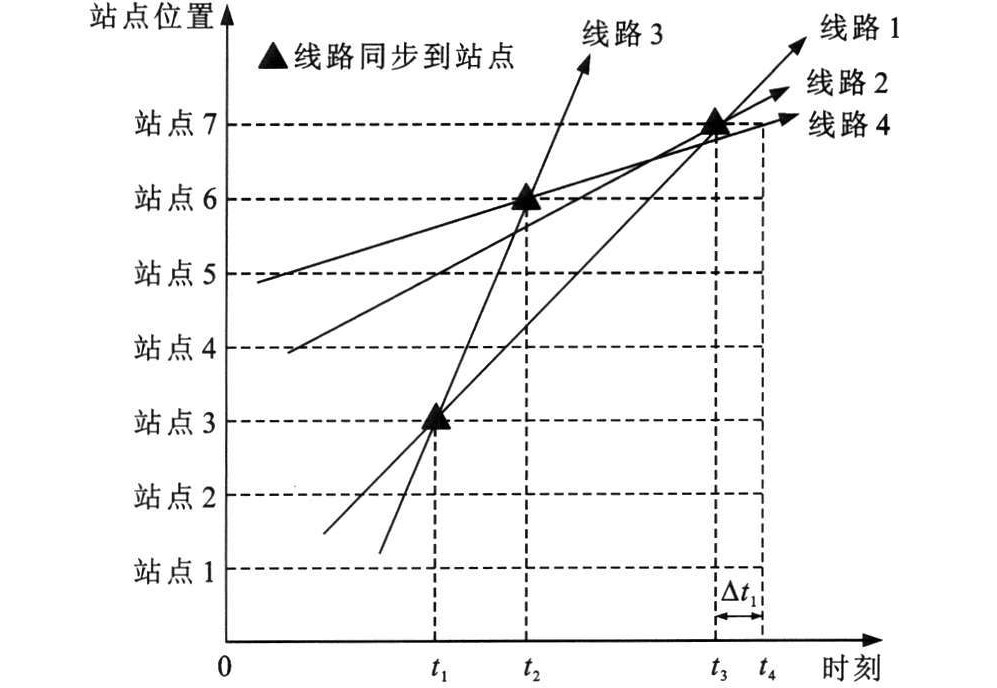Optimization method of bus time based on synchronization diversity
-
摘要: 分析了现有公交调度方法中大间隔发车、局部收敛与时间不协调等问题, 以最大同时到站次数和最大同时到站车辆数量为优化目标, 以末车定时、站点允许排队长度、服务质量、线路服务时间跨度为约束条件, 建立了公交时刻优化方法, 设计了基于网络选点规则和网络同步规则的求解算法。计算结果表明: 当公交网络中存在2条线路与2个站点且发车时间在30 min内时, 应用提出的方法, 在2个站点共产生3次同步, 线路1的发车时刻分别为第5、15、20、30 min, 线路2的发车时刻分别为第0、10、30 min; 与现有方法相比, 同步次数减少1次, 发车时刻完全分布于规定时间内, 消除了剩余时间, 获得了非均匀化的发车间隔, 体现了同步的多样性。Abstract: The problems of existing bus scheduling method such as big interval departure, local convergence and time incoordination were analyzed. The maximum number and maximum bus number arrived at station at the same time were taken as optimization objectives, the fixed departure time of last bus, the allowable queue length of station, service quality and the time span of route service were taken as constraint conditions, an optimization method of bus time was built, and the solution algorithm based on network reconnaissance rule and network synchronization rule were designed. Calculation result indicates that when there are two routes and two stations, and departure time is less than 30 min, three synchronizations appear at two stations by using the proposed method.The departure times of route 1 are at 5, 15, 20, 30 min and the departure times of route 2 are at 0, 10, 30 min respectively.Compared with the existing method, the number of synchronization times decreases by one, all departure times completely distribute in given time, surplus time is eliminated, inhomogeneous departure intervals are gotten, and synchronization diversity is reflected.
-
Key words:
- traffic planning /
- bus scheduling /
- bus time /
- maximum synchronization /
- diversity /
- double-objective function
-
表 1 线路参数
Table 1. Line parameters
线路编号 服务起点时刻/min 服务终点时刻/min 发车间隔下限/min 发车间隔上限/min 发车次数 1 0 30 5 15 4 2 0 30 8 20 3 表 2 站点参数
Table 2. Station parameters
站点编号 泊位数量 停靠线路数量 总经过车次 最大发车次数 最小发车次数 总客流量/人次 1 2 2 7 4 3 250 2 2 2 7 4 3 200 表 3 站点1的时刻范围
Table 3. Time ranges of station 1

表 4 第1次更新后站点1的时刻范围
Table 4. Time ranges of station 1 after 1st rectification

表 5 第2次更新后站点1的时刻范围
Table 5. Time ranges of station 1 after 2nd rectification

表 6 站点2的时刻范围
Table 6. Time ranges of station 2

表 7 更新后站点2的时刻范围
Table 7. Time ranges of station 2 after rectification

表 8 本文方法计算结果
Table 8. Calculation result of proposed method
线路1发车时刻/min 线路2发车时刻/min 在站点1的同步时刻/min 在站点2的同步时刻/min 总同步次数 5 0 12 3 15 10 22 20 30 37 30 表 9 现有方法计算结果
Table 9. Calculation result of existing method
线路1发车时刻/min 线路2发车时刻/min 在站点1的同步时刻/min 在站点2的同步时刻/min 总同步次数 5 0 12 4 13 8 20 21 16 28 26 43 -
[1] RAPP M H, GEHNER C D. Transfer optimization in an interactive graphic system for transit planning[J]. Transportation Research Record, 1976(619): 27-33. [2] KYTE M, STANLEY K, GLEASON E. Planning, implementing, and evaluating a timed-transfer system in Portland, Oregon[J]. Transportation Research Record, 1982(877): 23-29. [3] ABKOWITZ M, JOSEF R, TOZZI J, et al. Operational feasibility of timed transfer in transit systems[J]. Journal of Transportation Engineering, 1987, 113(2): 168-177. doi: 10.1061/(ASCE)0733-947X(1987)113:2(168) [4] KLEMT W D, STEMME W. Schedule synchronization for public transit networks[J]. Lecture Notes in Economics and Mathematical Systems, 1988(308): 327-335. [5] VOSS S. Network design formulations in schedule synchronization[J]. Lecture Notes in Economics and Mathematical Systems, 1992(386): 137-152. [6] LEE K, SCHONFELD P. Optimal slack time for timed transfers at a transit terminal[J]. Journal of Advanced Transportation, 1991, 25(3): 281-308. doi: 10.1002/atr.5670250304 [7] DESILETS A, ROUSSEAU J M. SYNCHRO: a computer-assisted tool for the synchronization of transfers in public transit networks[J]. Lecture Notes in Economics and Mathematical Systems, 1992(386): 153-166. [8] NELSON M, BRAND D, MANDEL M. Use and consequences of timed-transfers on US transit properties[J]. Transportation Research Record, 1981(798): 50-55. [9] ADAMSKI A. Transfer optimization in public transport[J]. Lecture Notes in Economics and Mathematical Systems, 1995(430): 23-38. [10] ADAMSKI A, CHMIEL W. Optimal service synchronization in public transport[C]∥IEEE. Proceedings of the45th Annual Conference of the ORSNE. Wellington: IEEE, 2010: 140-149. [11] MAXWELL R R. Intercity rail fixed-interval, timed-transfer, multihub system: applicability of the"integraler taktfahrplan"strategy to North America[J]. Transportation Research Record, 1999(1691): 1-11. [12] BECKER A J, SPIELBERG F. Implementation of a timed transfer network at Norfolk, Virginia[J]. Transportation Research Record, 1999(1666): 3-13. [13] CEDER A. Bus timetables with even passenger loads as opposed to even headways[J]. Transportation Research Record, 2001(1760): 3-9. [14] CEDER A, GOLANY B, TAL O. Creating bus timetables with maximal synchronization[J]. Transportation Research Part A: Policy and Practice, 2001, 35(10): 913-928. doi: 10.1016/S0965-8564(00)00032-X [15] CEDER A, STERN H I. Deficit function bus scheduling with deadheading trip insertions for fleet size reduction[J]. Transportation Science, 1981, 15(4): 338-363. doi: 10.1287/trsc.15.4.338 [16] CEDER A, TAL O. Designing synchronization into bus time-tables[J]. Transportation Research Record, 2001(1760): 28-33. [17] 石琴, 覃运梅, 黄志鹏. 公交区域调度的最大同步换乘模型[J]. 中国公路学报, 2007, 20(6): 90-94. https://www.cnki.com.cn/Article/CJFDTOTAL-ZGGL200706017.htmSHI Qin, QIN Yun-mei, HUANG Zhi-peng. Maximal synchronous transfer model of bus regional dispatching[J]. China Journal of Highway and Transport, 2007, 20(6): 90-94. (in Chinese). https://www.cnki.com.cn/Article/CJFDTOTAL-ZGGL200706017.htm -





 下载:
下载:







